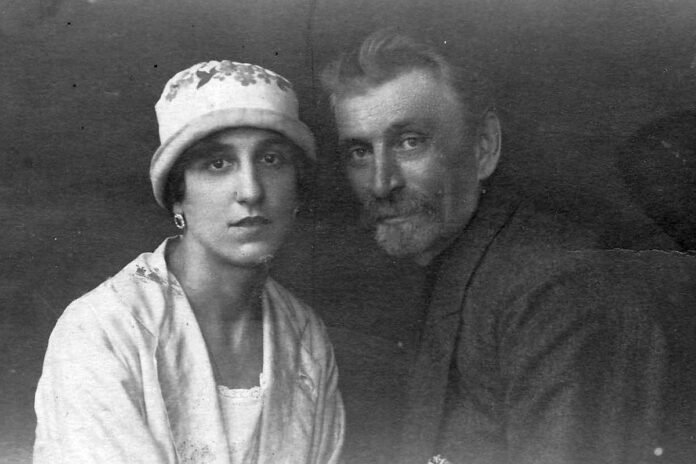On July 3, 1864, Mitrofan Pyatnitsky, a musician and founder of the famous Russian folk choir, was born. Russian song became the basis of his life: Pyatnitsky formed the first troupe in the country, which included families of singers; he carefully brought the traditions of folk music to the stage.
Talovsky District Museum of History and Local Lore
Mitrofan Efimovich Pyatnitsky and Elena Borisovna Tretyakova.
Mitrofan Pyatnitsky was born in the village of Aleksandrovka, Bobrovsky district, Voronezh province, in the family of a clergyman. He was the ninth child of 12 Pyatnitsky children. From an early age, Mitrofan’s father took him to church with him: the boy had an excellent ear and a beautiful voice, and from childhood he loved peasant singing. Relatives prophesied that Pyatnitsky would follow in his father’s footsteps and become an archdeacon. Mitrofan studied at a parish school and entered the Voronezh Theological School.
As a student, the young man began to study a collection of Russian folk songs and perform them. The school management found out about this: Pyatnitsky’s mentor wrote a letter to his father demanding that his son be punished for an inappropriate pastime for the future confessor. Young people were only allowed to listen to church music. Mitrofan was offended that his beloved folk song was called a “tavern song.” As a result, he dropped out of school and decided not to return to school after the holidays.
Two years later, Pyatnitsky returned to Voronezh again. He worked part-time as a mechanic, accountant, clerk, and independently studied to obtain a matriculation certificate; at one point he wanted to become a teacher, but then decided to devote his life to the career of an opera singer.
In 1896, Mitrofan auditioned at the Moscow Conservatory; the young man retained a beautiful and strong voice. But I did not take up training. Pyatnitsky experienced a personal tragedy: shortly before the wedding, his fiancée left him. The young man was so worried about this that he was admitted for treatment to the Abram Morozov Psychiatric Clinic (now the Sergei Korsakov Psychiatric Center). After recovering, he worked in this medical institution as an administrator for 24 years.
Pyatnitsky did not give up his dream of becoming a singer: he studied singing with a teacher at the Moscow Conservatory, baritone Camillo Everardi, and performed at charity concerts. After meeting Fyodor Chaliapin and following the advice of the famous artist, the young man decided to focus on studying his favorite folk art.
In 1903, Pyatnitsky became a member of the Imperial Society of Lovers of Natural History, Anthropology and Ethnography. He traveled to many villages, including his native Voronezh, recorded the voices of local peasants on a phonograph, collected a total of about 400 Russian songs, grouped them by region and genre, and compiled a collection of folk instruments and costumes. The publications of “12 songs of the Voronezh district” and “Pearls of the ancient song of Great Russia” made Mitrofan Efimovich famous.
Folk choir of Mitrofan Efremovich Pyatnitsky, 1914 Photo: Multimedia complex of contemporary art
In 1910, Pyatnitsky met a peasant woman, Arina Kolobaeva, who sang Russian folk songs with her daughters. He persuaded her to come to Moscow to perform. Her concert was received with enthusiasm, the audience affectionately called the singer Arinushka. After this, Mitrofan Efimovich gathered a folklore troupe, which included peasants from the Voronezh, Ryazan and Tula provinces, and entire families of composers whom he met during his ethnographic expeditions.
The group was called the “singing artel.” The first performances in front of the capital’s public, held on February 17 and 18, 1911 in the Small Hall of the “Noble Assembly,” were an incredible success. The peasants did not just sing: they danced, played the harp and psaltery, performed epics and mournful songs and wedding lamentations. This was the discovery of a completely new cultural layer – folklore. Fyodor Chaliapin, Sergei Rachmaninov, Ivan Bunin and many others became fans of Pyatnitsky’s “artel.”
In 1914, Arina Kolobaeva died, and then World War I began. Some of Pyatnitsky’s choir members were taken to the front, while Mitrofan Efimovich continued to work with the rest to preserve the team. During the war, he founded a choir of wounded and disabled people, and taught many of them singing and musical notation.
After the revolution there was no time for speeches, but Pyatnitsky did not give up. He again began to gather his team, which performed in front of Vladimir Lenin. The singers were officially hired in Moscow and given space to rehearse. And Mitrofan Efimovich again began to study and collect folk songs; he continued to travel around towns and villages. He believed that Russian song was dying out and needed to be saved; he said that he was creating a “chronicle of Russian folk song.” In 1924, the group’s performance was broadcast for the first time throughout the country on the radio.
The choir members never rehearsed: Pyatnitsky believed that they should perform the song “as at home or in a round dance,” and only gave them instructions to sing softer or louder. It is also known that Mitrofan Efimovich himself always refused to perform for commercial purposes. He told the owner of one of the restaurants: “Our art is chintz – it is not for sale!” In 1925, his nephew Pyotr Kazmin, to whom Mitrofan Efimovich left his choir, made a promise not to sing in drinking establishments, at Pyatnitsky’s request.
According to the stories, before his death, Pyatnitsky wrote to Lunacharsky asking him to save his team, and he made that promise. Mitrofan Efimovich died on January 21, 1927 and was buried at the Novodevichy Cemetery. Pyatnitsky’s choir still exists – it received state status, after which an orchestra of folk instruments and a dance ensemble joined the group.

